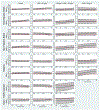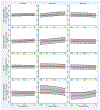Race-ethnic differences in the associations of maternal lipid trait genetic risk scores with longitudinal fetal growth
- PMID: 31383602
- PMCID: PMC6885118
- DOI: 10.1016/j.jacl.2019.06.007
Race-ethnic differences in the associations of maternal lipid trait genetic risk scores with longitudinal fetal growth
Abstract
Background: Fetal growth, an important predictor of cardiometabolic diseases in adults, is influenced by maternal and fetal genetic and environmental factors.
Objective: We investigated the association between maternal lipid genetic risk score (GRS) and fetal growth among 4 US racial-ethnic populations (Whites, Blacks, Hispanics, and Asians).
Methods: We extracted genotype data for 2008 pregnant women recruited in the National Institute of Child Health and Human Development Fetal Growth Studies-Singleton cohort with up to 6 standardized ultrasound examinations. GRS was calculated using 240 single-nucleotide polymorphisms previously associated with higher total cholesterol (GRSTChol), low-density lipoprotein cholesterol (GRSLDLc), and triglycerides (GRSTG) and lower high-density lipoprotein cholesterol (GRSHDLc).
Results: At 40 weeks' gestation, a unit increase in GRSTG was associated with 11.4 g higher fetal weight (95% confidence interval [CI] 2.8-20.0 g) among normal-weight Whites, 26.3 g (95% CI 6.0-46.6 g) among obese Blacks, and 30.8 g (95% CI 6.3-55.3 g) among obese Hispanics. Higher GRSHDLc was associated with increased fetal weight across 36 to 40 weeks among normal-weight Whites and across 13 to 20 weeks among normal-weight Asians, but with decreased fetal weight across 26 to 40 weeks among normal-weight Hispanics. Higher GRSTChol was suggestively associated with increased fetal weight in males and decreased in females. Associations remained consistent after adjustment for serum lipids.
Conclusion: Associations between fetal weight and maternal lipid GRS appear to vary by maternal race-ethnic group, obesity status, and offspring sex. Genetic susceptibility to unfavorable lipid profiles contributes to fetal growth differences even among normal-weight women suggesting a potential future application in predicting aberrant fetal growth.
Keywords: Birth weight; Fetal growth; Genetic risk score; Maternal lipid traits.
Published by Elsevier Inc.
Figures


Similar articles
-
Ancestry-Matched and Cross-Ancestry Genetic Risk Scores of Type 2 Diabetes in Pregnant Women and Fetal Growth: A Study in an Ancestrally Diverse Cohort.Diabetes. 2022 Feb 1;71(2):340-349. doi: 10.2337/db21-0655. Diabetes. 2022. PMID: 34789498 Free PMC article.
-
Racial/ethnic variation in the association of lipid-related genetic variants with blood lipids in the US adult population.Circ Cardiovasc Genet. 2011 Oct;4(5):523-33. doi: 10.1161/CIRCGENETICS.111.959577. Epub 2011 Aug 10. Circ Cardiovasc Genet. 2011. PMID: 21831959
-
Trans-ethnic meta-analysis of genome-wide association studies identifies maternal ITPR1 as a novel locus influencing fetal growth during sensitive periods in pregnancy.PLoS Genet. 2020 May 14;16(5):e1008747. doi: 10.1371/journal.pgen.1008747. eCollection 2020 May. PLoS Genet. 2020. PMID: 32407400 Free PMC article.
-
Fetal growth standards: the NICHD fetal growth study approach in context with INTERGROWTH-21st and the World Health Organization Multicentre Growth Reference Study.Am J Obstet Gynecol. 2018 Feb;218(2S):S641-S655.e28. doi: 10.1016/j.ajog.2017.11.593. Epub 2017 Dec 22. Am J Obstet Gynecol. 2018. PMID: 29275821 Free PMC article. Review.
-
Folic acid supplementation and malaria susceptibility and severity among people taking antifolate antimalarial drugs in endemic areas.Cochrane Database Syst Rev. 2022 Feb 1;2(2022):CD014217. doi: 10.1002/14651858.CD014217. Cochrane Database Syst Rev. 2022. PMID: 36321557 Free PMC article.
Cited by
-
Establishment of trimester-specific reference intervals of serum lipids and the associations with pregnancy complications and adverse perinatal outcomes: a population-based prospective study.Ann Med. 2021 Dec;53(1):1632-1641. doi: 10.1080/07853890.2021.1974082. Ann Med. 2021. PMID: 34498500 Free PMC article.
-
Lipid profile in women of different ethnicity with gestational diabetes: Relationship with fetal growth.J Diabetes Investig. 2024 Mar;15(3):355-363. doi: 10.1111/jdi.14124. Epub 2023 Dec 13. J Diabetes Investig. 2024. PMID: 38087914 Free PMC article.
-
Genomic study of maternal lipid traits in early pregnancy concurs with four known adult lipid loci.J Clin Lipidol. 2023 Jan-Feb;17(1):168-180. doi: 10.1016/j.jacl.2022.10.013. Epub 2022 Nov 17. J Clin Lipidol. 2023. PMID: 36443208 Free PMC article.
-
Ancestry-Matched and Cross-Ancestry Genetic Risk Scores of Type 2 Diabetes in Pregnant Women and Fetal Growth: A Study in an Ancestrally Diverse Cohort.Diabetes. 2022 Feb 1;71(2):340-349. doi: 10.2337/db21-0655. Diabetes. 2022. PMID: 34789498 Free PMC article.
-
Lipid and lipoprotein concentrations during pregnancy and associations with ethnicity.BMC Pregnancy Childbirth. 2022 Mar 24;22(1):246. doi: 10.1186/s12884-022-04524-2. BMC Pregnancy Childbirth. 2022. PMID: 35331154 Free PMC article.
References
-
- Barker D, The intrauterine origins of cardiovascular disease. Acta Paediatrica, 1993. 82: p. 93–99. - PubMed
-
- Vrijkotte TG, et al., Maternal triglyceride levels during early pregnancy are associated with birth weight and postnatal growth. J Pediatr, 2011. 159(5): p. 736–742 e1. - PubMed
-
- Clausen T, et al., Maternal anthropometric and metabolic factors in the first half of pregnancy and risk of neonatal macrosomia in term pregnancies. A prospective study. Eur J Endocrinol, 2005. 153(6): p. 887–94. - PubMed
-
- Kitajima M, et al., Maternal serum triglyceride at 24--32 weeks’ gestation and newborn weight in nondiabetic women with positive diabetic screens. Obstet Gynecol, 2001. 97(5 Pt 1): p. 776–80. - PubMed
Publication types
MeSH terms
Substances
Grants and funding
LinkOut - more resources
Full Text Sources
Medical
Miscellaneous

